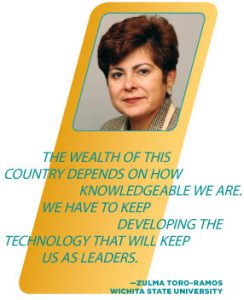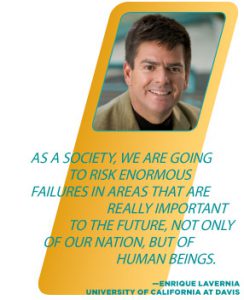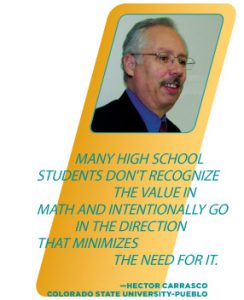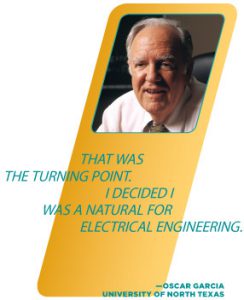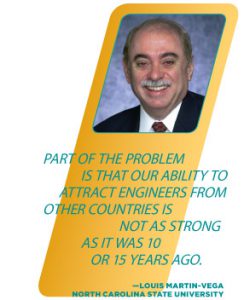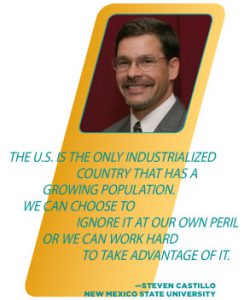A FUTURE ENGINEER?
BY MARGARET LOFTUS
AS a young boy growing up in Cuba, Oscar Garcia loved to tinker with radios, but it wasn’t until he got a toy motor kit for Christmas that he was bitten by the engineering bug. With the instructions for assembling the motor in English, the 12-year-old Garcia enlisted the help of an electrical engineering student who lived down the street from his family. “He and I put it together,” remembers Garcia, “but it didn’t work, so I was very chagrined.” He wouldn’t be deterred, however, and worked on it himself until it purred. “That was the turning point. I decided I was a natural for electrical engineering.” Garcia went on to an illustrious career that has included designing computers for IBM, a stint at the National Science Foundation and his current post as dean of the College of Engineering at the University of North Texas.
But as a Hispanic-American, Garcia is an exception to the rule. While they are the largest minority group in the United States at 14.5 percent of the population, only 4 percent of engineers in the workforce in this country are Hispanic. Just 7 percent of the bachelor’s degrees in engineering, 5 percent of master’s degrees and even fewer doctoral degrees are awarded to Hispanics. Meanwhile, the Hispanic birthrate and immigration continue to outpace those of African-Americans and non-Hispanic whites: The U.S. Latino population is expected to grow 45 percent by 2015, compared with 1 percent for whites. With the chasm threatening to grow even wider in just a few short years, many engineering educators say that attracting more Hispanics to engineering and engineering education is no longer a choice.
The consequences of not doing so may be severe, says Enrique Lavernia, the dean of the University of California at Davis College of Engineering. “As a society, we are going to risk enormous failures in areas that are really important to the future, not only of our nation, but of human beings.” He points to the environment and the latest energy crisis as examples. “We need to have a highly educated and innovative engineering workforce. Clearly that demands diversity.” Prism spoke with Lavernia and several other Hispanic engineering school deans about the crisis, what inspired them to a career in engineering and education and what can be done to inspire others.
The dearth of Latinos in engineering is part of a larger issue, which of course, is the potential shortage of engineers in the United States. Even if diversity didn’t matter, the population growth of the white males who have long filled the ranks of engineering positions and graduate schools couldn’t keep pace with the demand. For years, foreign nationals—many of them Asian—have filled the gap. China, India, South Korea and Japan, in particular, are veritable engineer factories with their universities pumping out 470 percent more bachelor’s degrees in engineering each year than the United States. But more and more of the recipients of those degrees are choosing to stay home. “Part of the problem is that our ability to attract engineers from other countries is not as strong as it was 10 or 15 years ago,” explains Louis Martin-Vega, dean of the North Carolina State University College of Engineering. One of the reasons is that the opportunities in their own countries are becoming greater, he says. “That’s just the reality.”
Reality check No.2 is that unless we can make engineering a whole lot more appealing to all underrepresented minorities, the United States stands to lose its position in the world as a technological innovator. “The wealth of this country depends on how knowledgeable we are. We have to keep developing the technology that will keep us as leaders,” argues Zulma Toro-Ramos, a native of Puerto Rico and dean of the Wichita State University (WSU) College of Engineering. “We won’t be able to do that unless we have enough engineers.”
And for that we don’t need to look any farther than our own background, says New Mexico State University College of Engineering Dean Steven Castillo, “The U.S. is the only industrialized country that has a growing population. We can choose to ignore it at our own peril or we can work hard to take advantage of it. We have a tremendous amount of human capital in the Hispanic population that we’re not realizing.”
But it’s not all about numbers. A more diverse pool of engineers comes up with better solutions. Jorge Auñón, dean of the University of Alabama in Huntsville College of Engineering, who is originally from Cuba, explains that Latinos think differently from their counterparts. For example, he says that his department chair from Argentina has a more humanistic point of view than most of his other colleagues. “When he and I sit down, we talk first about our families,” Auñón says. “Most everyone else is all business. The protocol is totally different.”
Changing Times
Another factor is pure economics. In previous waves of immigration, there were more opportunities for unskilled workers. Hispanics account for more than 40 percent of all high school dropouts in the United States. In the past, these kids may have gone on to make a fair wage in the manufacturing sector. “You didn’t have to go to school to earn a decent wage,” Castillo says.
Today is a whole other story: The United States will lose 7 million jobs in manufacturing in the next 10 years, with the same number of jobs being added in technology. As a result, immigrants and first-generation Americans can no longer afford not to have a college degree. Growing up in a small rural town south of Albuquerque, Castillo says he had a lot of smart Hispanic friends who didn’t go to college because their family valued work over education or they just plain couldn’t afford it. And while the idea of forgoing a college degree to work may seem short-sighted to some, others see it as doing the right thing. “The idea of helping your family is very prevalent [in Hispanic cultures],” Garcia explains—making it tough to convince high school kids and their parents that college is important and doubly tough to push graduate school.
Nonetheless, many engineering schools are trying to do just that. Like any marketing campaign, the first step is to promote awareness, oftentimes starting as young as kindergarten. Outreach is a key element of MESA (Mathematics, Engineering and Science Achievement), a nationally recognized consortium of programs in several states designed to attract and support disadvantaged and underrepresented students in math-based degrees. Funded by the National Science Foundation and industry, MESA features planning, community service, family involvement, academic enrichment, hands-on engineering activities, career advising, field trips, competitions and workshops. At the School of Engineering and Computer Science (SOECS) at the University of the Pacific in Stockton, Calif., for example, the MESA staff works with engineering faculty to encourage and teach area students in grades four through 12—35 percent of whom are Hispanic—about concepts within various engineering fields. SOECS Dean Ravi Jain credits MESA, along with a dedicated recruitment process that reaches Hispanic students at their school sites, with the school’s 15 percent Hispanic population—a three-fold increase over the past 14 years.
Other engineering programs have seen progress with homegrown initiatives. In Wichita, where the Mexican population has mushroomed in recent years, thanks to the demand for workers in the area’s meat-packing industry, WSU College of Engineering sponsors a high school robotics competition run by a group of retired engineers. WSU Dean Toro-Ramos, who was hired in 2005, in part, to bolster the college’s Hispanic population, explains, “These students get exposed to what engineering is all about. We’ve been able to attract some students who have participated in the program, the goal is to get more and more of them.” The school also partners with industry and the university’s College of Education to host a similar competition for middle school students. In another program, supported by Honda, middle school students are invited to join monthly sessions at a community learning center that focus on problem-solving and expose them to engineering. And as the Kansas affiliate for Project Lead the Way, the college helps to train math and science teachers to integrate engineering and technology into the curriculum.
Making Math Add Up
Of course , a curriculum rich in STEM (science, technology, engineering and math) subjects is one thing; getting kids to enroll in those courses is quite another. “Many high school students don’t recognize the value in math and intentionally go in the direction that minimizes the need for it. This goes across the board for all ethnicities, but you see it more in economically depressed areas,” argues Hector Carrasco, engineering dean at Colorado State University-Pueblo, where Hispanics make up more than one-fourth of the engineering school. Not only is a solid math background essential to majoring in engineering, he says, “The best predictor of a student’s success in college is related to the rigor of math courses they took in high school.” That’s why Carrasco’s department assigns student mentors to schools in Pueblo where there’s a high percentage of kids from lower income families. The mentors tutor students as young as sixth graders in math and talk up college and financial aid opportunities.
Likewise, Wichita State has a co-advising program with middle and high school guidance counselors to help students choose coursework wisely, particularly math, so they won’t be at a disadvantage when it comes to higher education. Toro-Ramos, for one, knows how important this is: As an eighth grader in Puerto Rico she enrolled in a probability and statistics course as part of a government experiment. The class sparked her interest in math, which led to her career as an engineer. As part of her plan to boost the number of Hispanics majoring in engineering at WSU, she’s also proposed a partnership with the Wichita school district to educate Hispanic students and their parents about the opportunities in higher education and STEM fields. “For Hispanics, it’s very difficult to leave their communities and go somewhere else. If the institution is not in their backyard, it will be tough, so we have to reach out to them.”
To this end, several universities host summer camps to expose young Hispanics and other minorities to STEM subjects. New Mexico State University’s College of Engineering, for instance, brings 180 middle and high school students to campus each summer for intense math and science workshops. “We target demographics that we really want to push engineering on,” says Castillo, who became interested in engineering himself at a summer camp at rival University of New Mexico. “It’s been an extremely successful program for us.”
On top of formal programs, UC-Davis’s Lavernia stresses the power of role models. He meets with K-12 students as much as possible. “Typically a dean doesn’t do this, but being Hispanic gives me access to them that’s not typical.” NSF has helped by funding the recruitment of community college students, among whom his heritage resonates. “Many transfer students from community colleges are minorities. They see UC-Davis as too intimidating. I try to dispel that perception.” He also welcomes visits from younger students, describing a recent encounter with 70 fifth and sixth graders from a nearby largely Hispanic school district. “That’s when you really need to capture them, tell them they can do it, particularly female Hispanic students who have very few role models,” Lavernia says.
But the struggle doesn’t end there. Like other underrepresented engineering students, retention rates for Hispanics are downright dismal. “The engineering curriculum is so demanding that it’s very easy to fall out of sequence, it’s demoralizing and can often lead to drop out. It’s worse with Hispanic students,” Lavernia says. Out of the 600 bachelor of science degrees awarded in engineering at UC-Davis last June, 28 of them were earned by Latinos—representing about half of those who had enrolled as freshmen. To shore up those numbers, Lavernia has created an office devoted to the retention of disadvantaged students. “It’s important that students understand that expectations are high but that they are supported.” The unit offers 24-hour mentoring and arranges for participation in faculty research. Lavernia himself credits his own undergraduate research at Brown University with starting him on the path to become an engineering professor.
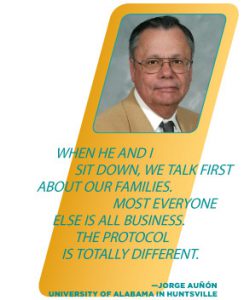
Fostering community is especially important for Hispanics who may feel even more isolated from their peer group than the typical freshman. Another Texas A&M program, Connects, helps students transition to college and provides financial support for low-income, high-ability students through scholarships. Like the learning communities, students take common courses but in addition, Connects students live in the same residence hall. In the first year of the program, first-semester retention rates were 87.2 percent compared with the college average of 75 percent.
Academia, a Hard Sell
Another challenge not unique to Hispanics but possibly more prevalent is attracting them to graduate school and into academia. When Lavernia told his father that he wanted to become a professor, his father—an engineer himself—jokingly chided him for “not wanting to work for a living.” Castillo explains that parents often present the largest obstacle when it comes to encouraging promising undergrads to pursue academia as a career. “Parents say, ‘Why are you doing this? Go out and make money.’ ” Indeed, the salaries dangled in front of freshly minted engineers are hard to pass up, especially for someone who may have come from an underprivileged background or has racked up unwieldy students loans.
Some programs are working to counter this, such the NSF-funded Bridge to the Doctorate program that specifically targets minority students, offering fellowships and assisting them in applying to Ph.D. programs around the country. And at Michigan State University’s College of Engineering, an initiative with support from the Alfred P. Sloan Foundation is focused on recruiting and mentoring Hispanic engineering grad students. As a result, the past seven years have seen an increase of 36 percent in the enrollment of African-American and Hispanic doctoral students and a retention rate of 90 percent.
While these incremental successes are promising, the deans agree that much work remains. Martin-Vega says that stressing the breadth of engineering is crucial to attracting more Hispanics to the field. Growing up in Puerto Rico where several engineers were in prominent government positions, Martin-Vega credits these role models with his own interest in engineering.
“The message I received was that an engineering degree would provide you with a career in many professional endeavors and not just highly technical careers.” Indeed, research has shown that service-oriented work is more attractive to under-represented minorities. “Usually Hispanics see engineering as a very dry profession. One that doesn’t really deal with people,” explains Toro-Ramos, which is why she has developed a bioengineering program at WSU. “If they know that they will have the opportunities to work with communities, that will attract them more.”
Lavernia believes there’s room for optimism. “This is a portion of the population that can use engineering as an incredible stepping stone, but they need help. It behooves us to be aggressive.”
Margaret Loftus is a freelance writer based in Charleston, S.C.
Category: Cover Story

